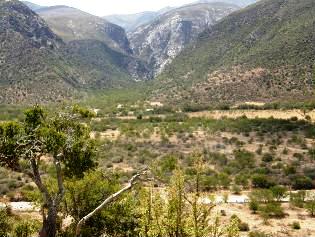
As part of the Water Circle seminar series, Prof Kate Rowntree from the Rhodes University Geography Department recently presented a talk entitled "Landscape connectivity, a hydro-geomorphic framework for landscape restoration in the Baviaanskloof, South Africa" to address landscape degradation issues.
Prof Rowntree described the degradation issues that have been identified in the Baviaanskloof, which particularly affect the farmers in the area, and presented a framework for an integrated approach to catchment restoration based on the geomorphological principle of connectivity. “Connectivity enables us to integrate landscape structure and function at a number of time and space scales. It also allows us to think about complex systems in a non-linear way,” she added.
She further described the concept as a measure of the potential for energy or materials such as water, sediments and nutrients to move over the landscape. Disconnectivity is when connectivity is disrupted “so that instead of materials being moved across the landscape they are stored within certain locations”.
Evidence of former wetlands in the area was discovered when HOD of Environmental Science, Prof Fred Ellery joined a group restoration scientists in the Baviaanskloof on a field trip, which subsequently prompted the research project. This research is being carried out by a number of students from Rhodes University under the joint supervision of Profs Rowntree and Ellery, “under the general theme of catchment restoration” says Prof Rowntree.
The restoration project is part of joint initiative with the Dutch group Living Lands through their research network PRESENCE, a network that has engaged with the philosophy of integrated catchment management to guide future developments in the valley.
The semi-arid Baviaanskloof lies on the Perdeberg fault line in the Karoo. It is a site of commercial agriculture, tourism and conservation (including the protection of leopards). Irrigation is therefore essential in promoting both agricultural activities and tourism. The farmer’s main source of water for irrigation is stored in the coarse alluvium and the steep kloofs are an important source of groundwater. “There is lots of potential to store water and create a more or less continuous flow, feeding into wells the farmers have dug into the alluvial floor,” says Prof Rowntree.
Alluvial fans are gentle slopes that rise above the valley floor. “Alluvial fans are important buffers between the water coming out of slot canyons and the river system,” she says. By making an incision into the alluvial fan, farmers have diverted water away from the fans. They now want to restore the buffering capacity of the fans by blocking these incised channels and re-directing water onto the fan surface. But she emphasises that it “is important to realise that by disconnecting the system at one point you might be altering present day processes in a negative fashion”.
“One idea here is to replant spekboom, reduce the hillslope connectivity and reduce flooding. But we need to think about the processes that are linked to connectivity or disconnectivity and whether it’s worth it,” she says. As a case in point, she referred to how a small wetland may have developed because the incised fan brings sediment into the channel where it creates a barrier.
“By cutting off this sediment supply to the channel it may be that erosion will cut through this barrier and destroy the wetland. The point I wanted to make was that one needs to look at connectivity/disconnectivity within the broader system before taking action, rather than rushing in with a bulldozer (literally) as has happened in the past,” concluded Prof Rowntree.
